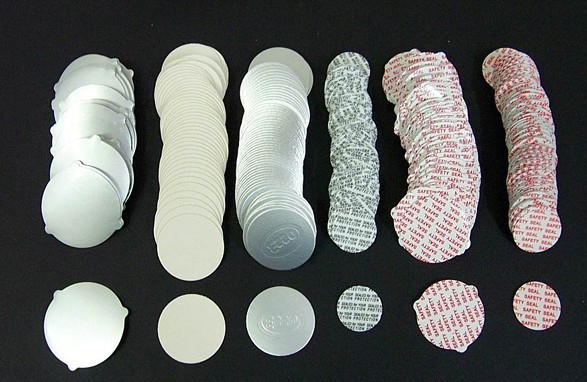1. Induction seal liners, or innerseals or wads, come in two main types, with and without a wax bonded backing liner These are often referred to as one piece and two piece:
The facing of both types is similar, an aluminium film laminated to a heat seal layer ; the two piece type then has an additional backing liner or 'wad'which is bonded to the facing layers D and E by a layer of 'wax' adhesive.
2. The one piece type of liner is removed from the cap entirely after the sealing process whereas the two piece leaves the backing liner (wad) in the cap for improved resealing after the initial opening.
3. The two piece liner has a 'wax' layer bonding the sealing layers to the backing board. The heat of the induction sealing process causes this wax layer to melt and it is absorbed into the backing board or other layer so that on cooling the two parts are separate.
4. The heat from the sealer causes the wax to melt progressively inwards from the edge. If correctly done the wax will completely free the liner facing, alternatively a small central area of unmelted wax may deliberately be left to retain the cap in place after sealing. This can avoid the need for subsequent cap re-tightening.
In all cases it is the heat seal layer which bonds to the container not the aluminium itself. The exact nature of this heat seal determines whether the induction liner will be peelable or full weld type and the types of container the foil will adhere to e.g. HDPE, PP, PET, glass etc.
5. All Induction Sealing Materials can be divided into two components viz: Single Piece Base Liners & the Sealing Film. Sealing Film have the Aluminum Foil available in thickness of as low as 9 Microns to 60 Microns.& a sealant suitable for it appropriate container.
The broadly uses Base Lining Materials in Induction Sealing are:
• Duplex Board
• Pulp Board (FBB)
• EPE
All these base liners can also be laminated with Paper, PE, PET or many other available substrates to get the additional properties along with the basic properties of the base liners.
The broadly used Sealing Material combinations are:
• Foil / Sealant
• Paper / Foil /Sealant
• Foil / Universal Coat
• Paper / Foil / Universal Coat.
• PE / Foil / Sealant
• PET / Foil /Sealant
• PE / Foil / PET / Sealant
• PET / Foil / PET / Sealant
• Paper / Foil / PET /Sealant
• Sealants are available for sealing containers having Dry & Liquid Products.
• Sealants suitable for PE, PET, PVC, PP, PS, and Glass Containers are provided.





